In the fall of 1994 I befriended a community of some two dozen heroin injectors and crack smokers surviving under the overpasses of a tangle of freeways six blocks from where I lived in San Francisco. The full force of the Reagan-era cutbacks from the 1980s had trickled down to the street, shredding the already rachitic U.S. welfare safety-net. Inner-cities were gentrifying (especially those linked to the epicenters of global finance capital such as San Francisco). The former skid row habitat for the unstable urban poor—cheap single-residency hotels—was being converted into multi-million dollar condominiums. Urban police forces had not yet systematized, routinized and replicated their zero-tolerance enforcement, harassment/incarceration dragnets (Wacquant 2009) and homelessness, consequently, was at its most visible. Bourgeois residents like me could not walk down a block or drive up a freeway entrance ramp in downtown San Francisco without being solicited for spare change. I obtained a National Institutes of Health HIV prevention grant and for the next 12 years, together with a photographer/anthropologist collaborator Jeff Schonberg and several additional ethnographic team members, we followed the social network of homeless addicts surviving in my neighborhood, documenting the unhealthy effects of indigence and substance abuse.
In the fall of 1994 I befriended a community of some two dozen heroin injectors and crack smokers surviving under the overpasses of a tangle of freeways six blocks from where I lived in San Francisco. The full force of the Reagan-era cutbacks from the 1980s had trickled down to the street, shredding the already rachitic U.S. welfare safety-net. Inner-cities were gentrifying (especially those linked to the epicenters of global finance capital such as San Francisco). The former skid row habitat for the unstable urban poor—cheap single-residency hotels—was being converted into multi-million dollar condominiums. Urban police forces had not yet systematized, routinized and replicated their zero-tolerance enforcement, harassment/incarceration dragnets (Wacquant 2009) and homelessness, consequently, was at its most visible. Bourgeois residents like me could not walk down a block or drive up a freeway entrance ramp in downtown San Francisco without being solicited for spare change. I obtained a National Institutes of Health HIV prevention grant and for the next 12 years, together with a photographer/anthropologist collaborator Jeff Schonberg and several additional ethnographic team members, we followed the social network of homeless addicts surviving in my neighborhood, documenting the unhealthy effects of indigence and substance abuse.
Our Punitive Era
Our Punitive Era
This span of years from 1994 to 2007 was a terrible time for the poor in the United States and throughout much of the rest of the world: 1) The punitive version of neoliberalism was consolidating in the United States and was achieving hegemony—even if unevenly (Harvey 2005)—across much of the globe. 2) The U.S. War on Terror was inaugurated with great bloodshed, routinizing the curtailment of civil rights. 3) The recession of 2007-2009 accelerated the ongoing public subsidy of high finance, public service cutbacks, reinforcing the bulwark for the long-term rise in income inequality that has been occurring since the 1970s (McCall and Percheski).
Change in Violent and Property Crime, and Inmate and Total Population, 1960-2008
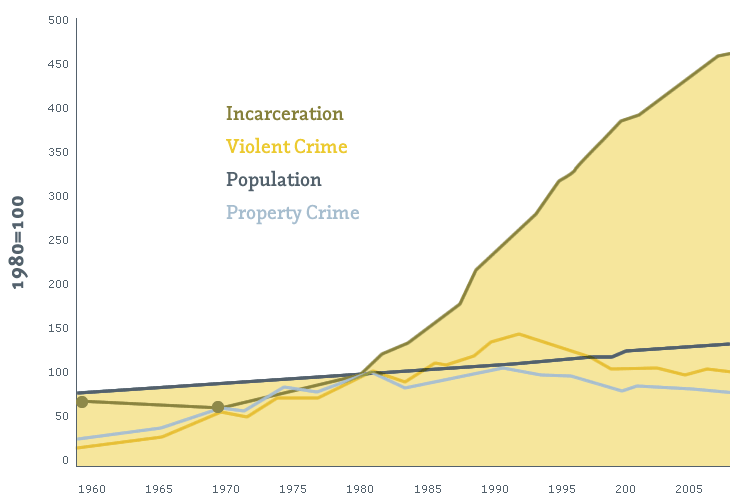
Source: Authors' analysis of FBI and BJS data, Center for Economic Policy Research 2010
Public health and social welfare programs in the United States have been overshadowed by state investment in incarceration despite decreasing or stable crime rates. Imprisonment has become the most aggressive and well-funded de facto housing and drug treatment policy for the poor. The prison population increased by over half a million men and women during our fieldwork years and many, if not most, of these new inmates were addicted to drugs and homeless (or unstably housed) at the time of their arrest. In the wake of those decades, indigent addicts in the United States in the 2010s continue to find themselves routinely trapped in an “abusive carceral cycle.” Their criminal record, exacerbated by a low skill level imposed by years of forced idleness in a purposefully hostile prison environment devoid of rehabilitative programs (Conover 2000), condemns them to chronic unemployment upon their release. Many if not most cycle immediately back into homelessness and do not find stable shelter again until they are re-incarcerated.
The goal of the book Righteous Dopefiend that came out of this project is to render more visible to public health practitioners, social scientists, and the wider general public concerned with contemporary social problems the human physical and emotional costs of the punitive version of neoliberalism that guides U.S. public policy towards indigent drug users. Drawing on critical social science theory and some philosophy and aesthetics, we present the health crisis of the homeless as a personal narrative that documents twelve years in the lives of a cast of characters who are confined by a moral economy of sharing and mutual betrayal in the context of addiction and the criminalization of poverty (Wacquant 2009).
Team Ethnography
Team Ethnography
Initially, we thought it would be difficult to establish a non-intrusive and ethical ethnographic relationship with the homeless who became the principle characters in our book given the fragility of their survival strategies and the everyday urgency of their drug use. They did not share our concern, however, and almost immediately integrated us non-problematically into their scene. As veteran survivor/hustlers, they recognized us as a potential resource, and most of them enjoyed being the center of our attention. They allowed us to accompany them as they scrambled for money, food, shelter, drugs and community while fleeing the police in their race to flood their bodies every day, several times a day, with heroin, alcohol and cocaine. Sometimes they coddled us as exotic, high-status outsiders. They enjoyed inviting us on visits to estranged family members, outings to the beach and visits to church. They took a certain pride in acting as expert guides when we accompanied them on scavenging expeditions and burglaries. They laid out blankets for us on the special occasions when we slept over in their encampments and on a few occasions they prayed for Jeff before going to sleep on the scavenged mattresses laid out next to him on their loading pallets in the mud. They introduced me to newcomers and transients possessively as “This is my professor I was telling you about….” Jeff was similarly introduced as, “…my photographer….”
In other words they enjoyed being taken seriously by a team of public health anthropologists and wanted to share the details of their survival strategies, dreams and multiple crises. As academics we tend to misread the real world stakes and ethical quandaries of our research. Anthropological and public health fieldwork ethics do not need to be in substantial contradiction with commonsensical, spontaneous human ethics. In the case of the homeless, for example, the best way to document the inadequacy of social services is to act as an “ethnographic accompagnateur”—akin to a social scientist version of the public health practitioner who is a community-based advocate/facilitator who promote adherence and access to medication in poor, inaccessible and underserved parts of the world (Behforouz, Farmer and Mukherjee 2004). In our case we assisted and accompanied the homeless to seek care with a secondary, complementary goal of constructively documenting the institutional mismanagement—with notable exceptions—by frontline services of poverty, ill-health and addiction. Consequently, we spent long hours attempting to facilitate (often unsuccessfully) their access to hospital emergency rooms, drug treatment centers, social service offices, community-based clinics and subsidized housing programs.
Ending an ethnographic project often feels like a betrayal of friendship, and both Jeff and I found it difficult to leave the “field.” We still feel guilty about it. This emotional quandary is inherent to anthropology's methodology and is exacerbated when one does fieldwork close-to-home across steep social power gradients.
Jeff and I wrote the book side-by-side, but we kept interrupting our writing and analysis to run down to the corner and “check on the guys.” Inevitably, we would come back with a half dozen more pages of new fieldwork notes, a “strategically targeted” follow-up interview (or two), and a full roll (or two) of freshly shot film. We eventually had to force ourselves to disengage with the “people, places and things”—as they say in the drug treatment community—of our fieldwork scene in order to complete the book. I left San Francisco for Philadelphia in the summer of 2007 to join the faculty at the University of Pennsylvania and finally finished the final draft.
The practical, artisanal value of conducting fieldwork as a team is underappreciated in anthropology in contrast to more positivist disciplines such as public health and clinical research in which collaboration is a routine and logistical practice necessary for managing random-controlled trials or survey interview to large numbers of research subjects. Nevertheless team work can be especially productive for interpretive humanities and social sciences precisely because of their non-positivist, social constructivist commitment to critical self-reflection. Multiple ethnographers writing together can explore the social desirability effects of the positionality of the researcher, appreciate the partiality of common sensical truths, and triangulate findings (i.e., compare notes, collect alternative perspectives and strategize follow-up fieldwork).
Collaboration is also practically useful for dealing with challenging fieldwork conditions. Daily life among homeless injectors can be emotionally draining and disorienting. They are embroiled in a politically-imposed suffering that manifests in an everyday interpersonal violence of intimate aggression and betrayal that can be destructive for them and alienating to an outsider. Conducting ethnography with a friend or colleague enables one to relax, concentrate more, and brainstorm during the very process of fieldwork itself. In the midst of the sometimes overwhelming events going on all around us, Jeff and I were able to step aside together and find a private spot to vent, strategize, joke or simply reassure one another after witnessing a particularly stormy set of arguments and hard-to-stomach events and interactions in a shooting encampment. This enabled us to stay in the field longer, feel safer, act more ethically and persevere more productively than had we been working alone. Perhaps most importantly, working as a team is also more fun.
Photo-Ethnography and the Power of Aesthetics
Photo-Ethnography and the Power of Aesthetics
About nine months after the beginning of the project, I had realized that text was not going to be enough to convey the routine violence of homeless survival on the street. Nor, contradictorily, would it capture the playful—at times ecstatic—sociality of out-of-treatment addicts when self-identifying with a certain pride as outlaws. I asked Jeff to join the project as a photographer, thinking it would be a one-or-two year collaboration with a student who might benefit with a master’s thesis and an article publication. Twelve years later, the intensity of the project had bonded us as friends and as intellectual colleagues and we finally published as co-authors what we call a ‘photo-ethnography’ critiquing the mismanagement of poverty, social inequality and substance abuse in the United States (Bourgois and Schonberg 2009).
It took us two or three years of intensive fieldwork to begin to understand how to integrate photography into an ethnographic project documenting such extremely painful, politically-structured suffering in our hometown. We also had to spend precious time navigating the bureaucratic human subjects restrictions developed for clinical science that are (in my view, inappropriately) imposed on non-invasive qualitative or visual, artistic research and often stifle creativity and data collection more than they protect vulnerable research participants. The characters in our book were eager to be part of our photo-ethnographic project, and they, like us, hoped (fantasized?) we might reach a larger readership than the traditional academic and clinical/service audiences who read either social science monographs or short public health peer review journal articles.
We also wanted to try to create a historical document of the public secret of homelessness in the 2000s that most people in the United States were walking or driving-by every day without noticing. Engaging with photography made me think more systematically about the artistic dimensions of ethnographic research that I had formerly taken for granted or considered peripheral to the analytical, theoretical and practical value of anthropological and especially of public health research. My commitment to link critical social science to the practical stakes of applied public health HIV prevention work had made me overly distrust the sometimes elite preciousness of cultural studies and the aesthetically oriented focus of much humanities research. This photo-ethnographic project, however, taught me to respect both the analytical and representational potential for melding art, social science and public health.
Initially my ethnographic concern with aesthetics and artistic representation had been limited to tape-recording and editing conversations to create a cultural linguistic document and archive of the poetry, philosophy and linguistic/oppositional genius of street language and slang. In my earlier work with crack sellers in East Harlem in the 1980s and early 1990s (Bourgois 2003), I had come to realize that presenting in publications the vibrancy and playful cadence of the often charismatically distinct street voices of my research participants allowed readers to recognize the fuller creative individuality of characters. It highlighted particularly thoughtful and articulate individuals or, conversely, flagged those who might be especially vulnerable to stereotyping because of their limited access to standard grammatical English. Individual patterns of street pronunciations and orthography can also reveal patterns of dyslexia and other learning/cognition challenges that may have limited a speaker’s educational and employment opportunities.
More subtly, exposure to the often skillful oratory of long-term addicts and energetic, entry-level drug sellers helps readers appreciate the fuller humanity of a population group that tends to be dismissed as social pariah losers, criminals, sociopaths or, at best, sick, self-destructive individuals. On an immediate, practical level, extensive quotations of street-speech-in-action allows public health readers to learn the indigenous street terms useful for writing more comprehensible and relevant survey questions about risky practices. Consequently, in my fieldwork I have always conducted my interviews as free-flowing conversations in the natural environment of the respondents that I guide towards specific themes relevant to my research interests. I then complement the recordings with detailed observational fieldnotes that triangulate the self-report on the audio and enhance its meaning with descriptions of the performative body language and emotional expressions that punctuate the conversations as well as the other inaudible interactions occurring simultaneously—such as crouching or whispering to escape detection by a passing pedestrian acquaintance or police car.
Unfortunately, I do not have the ability to think visually in the creative analytical way that Jeff does. He is able to observe, participate, audio record and photograph simultaneously without losing concentration. Within a few months of joining the project, Jeff’s fieldnotes and recordings were as good as his photographs, and soon he became as much of an ethnographer as he is a photographer. His photographic gaze gives his fieldnotes a fine-grained visual detail. Somehow he manages to take intimate pictures without interrupting social interaction.
Initially I was crassly utilitarian in my relationship to photography and urged Jeff to be more didactically linear and illustrative of risky practices and environments with his pictures. I argued for shooting with color film. Luckily, Jeff ignored me. Color photographs might have pushed his kind of documentation of bloody injection drug use, scars, homeless filth and suffering over the top. Furthermore, black and white photography references a form of art whose long history reminds viewers of the interpretive limits of visual data. The reality they are viewing has been purposefully edited, framed and contextualized to make a point.
To avoid objectifying or trivializing the photographs, we did not accompany them with captions (except as thumbnailed appendices at the end of the book); but neither did we trust the images to stand on their own. The topics of poverty and substance abuse—not to mention HIV, crime, racialized ethnicity, childhood trauma, non-normative sexuality, and interpersonal violence—are subject to moral judgmentalism. Consequently, we embedded Jeff’s pictures strategically in the text to encourage humane as well as critical analytical readings/viewings and to diminish ethno/class-centric or righteously normative projections. I find Jeff’s photographs to be alternately beautiful, jarring, evocative and documentary. We wrapped them in text (consisting of fieldnotes, dialogues, ethnographic analysis) that is alternately theoretical, narrative, evocative, policy-oriented. Our hope is that the merger of the mediums of photography, anthropology and public health can convey more than the sum of the parts methodologically, theoretically and representationally. Once again, by imbuing social science analysis with the emotional, documentary and aesthetic power of photo-ethnography we hope to open intellectual debate to a wider audience and to promote practical engagement.
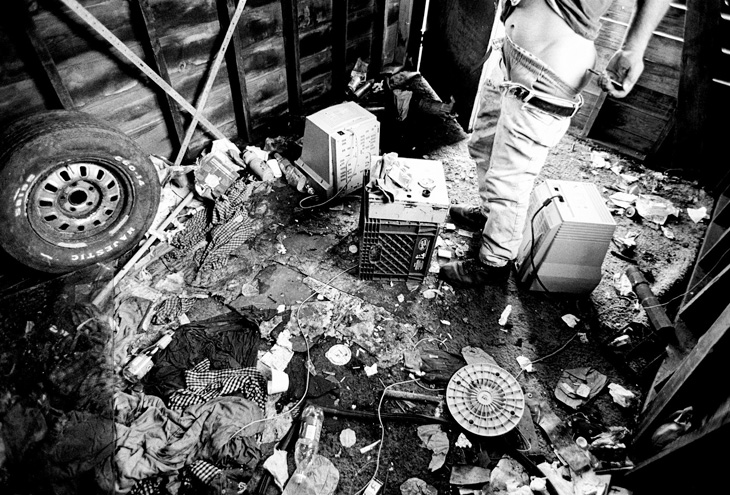
The photograph of the shooting gallery depicts the site of our social network’s primary injection locale for several months when off-the-books day labor was temporarily available selling Christmas trees on a nearby vacant lot. Jeff describes the moment he took the picture in a fieldnote that we inserted into a chapter on the legal income-generating strategies that had turned many of the homeless into inexpensive, just-in-time day laborers for fly-by-night seasonal employers.
This kind of artful, deliberately composed photograph standing alone without an accompanying text can devolve into sheer voyeurism. Jeff’s fieldnotes and the overall arguments of the book, however, prevent a pathologizing gaze by alerting readers to the logic for injecting in the midst of filth. They prevent a pathologizing gaze by showing analytically how the zero-tolerance War on Drugs has turned filthy nooks and crannies into the safest refuges for homeless injectors even though these same sites are dangerous incubators for propagating infectious diseases from the perspective of public health. On a more practical level the image conveys viscerally to public health and clinically-based readers the disjunction between hyper-sanitary HIV-prevention outreach messages and the reality of the risk environment faced by street-level addicts.
The image also reinforces the matter-of-factness of a fieldnote that might otherwise sound like hyperbole, hallucination or propaganda. The particular chapter in which the note and photo appear traces the neighborhood’s process of deindustrialization. The details of the photo reveal the marginal “trickle-down benefits” to the indigent of the booming, high-tech digital globalized economy of the San Francisco Bay Area’s Silicon Valley, which are limited to the presence of discarded computer monitors serving as seats in this shooting gallery. This chapter has a complicated theoretical argument about the political economic historic production of marginalization. It argues for re-framing Marx’s concept of class through a redefinition of the problematic, but creative, category of ‘lumpen proletariat’ to develop a “theory of lumpen abuse under punitive neoliberalism.”
To do this, we draw from Foucault’s understanding of subjectivity and biopower, Bourdieu’s concepts of symbolic violence and habitus and Primo Levi’s insights on the invisibility of Holocaust-like gray areas in routine daily life. These concepts help us re-define the lumpen as those vulnerable populations for whom biopower (the state-mediated forces and discourses of disciplinary modernity) has become abusive rather than productive. It problematizes the blame-the-victim implications of the concept of individual agency and worthiness among members of vulnerable population groups overwhelmed by the social forces buffeting them in their moment in history. Our era’s economy, its structures of service provision, and the symbolic violence of individual achievement and free market efficiency condemn increasingly large proportions of the transgressive poor to processes of lumpenization, which decimate bodies and amplify suffering.
Public Anthropology: Homelessness, Poverty and Addiction at the Museum
Public Anthropology: Homelessness, Poverty and Addiction at the Museum
The fledgling school of ‘public anthropology’ (Scheper-Hughes 2009) attempts to bring the participant-observation methodological tools and theoretical insights of our discipline to bear on the urgent social challenges of our era. Ideally, public intellectuals avoid becoming embroiled in the narrow details of partisanship or political positioning, so as to document the larger social-structural patterns that can be made visible through reflective, calm theoretical inquiry. The goal is to communicate to a wider public without dumbing-down or sanitizing an uncomfortable analysis. It requires entering policy debates and devoting energy to accessing wider media forums than those offered by our peer-review journals and university press publishers (including, with trepidation, interviews on Fox news and right-wing talk radio).
In the spirit of public anthropology we organized a photo-ethnographic exhibit at the Museum of Anthropology and Archeology at the University of Pennsylvania as well as an audio-visual installation at the Slought Foundation, an alternative art gallery, in Philadelphia. Old-fashioned, dusty-halled anthropology museums are beautiful, calm, reflective—even revered—spaces. They offer a valuable but underutilized forum for heightening the visibility of ethnographic work on public issues. The aesthetic medium of the museum display enables thoughtful audiences (who are different from those who buy and read academic books or public health peer review articles) to confront, evaluate and experience viscerally the world’s “everyday emergencies” (Taussig 1986).
Good museum designers can translate complex historical and social ideas into a narrative with a balance of images and minimal text. The University of Pennsylvania’s museum’s exhibit designer, Kathleen Quinn, transformed the jumble of text and photographs we initially submitted to her into an elegant, succinct display that covered the six central theoretical and topical themes we had wanted to emphasize. The display was mounted on a long hallway gallery so that walking through it might approximate a quasi-ethnographic experience of homelessness, addiction, and the war on drugs with a narrative timeline that introduced several of the main characters of the book in the context of the arguments:
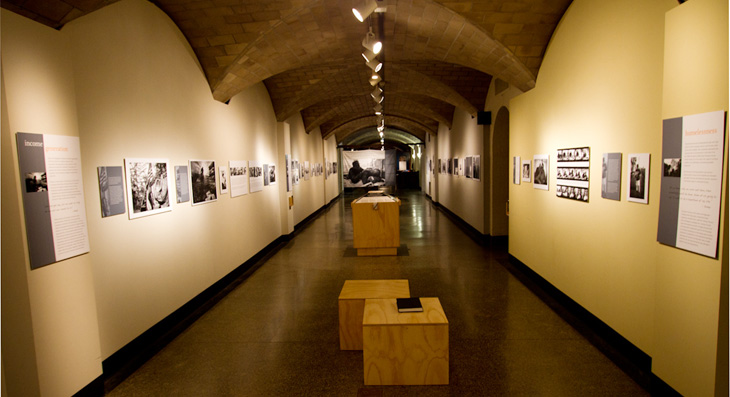
- The political economy of the lumpenization of the former industrial working class whose descendants make up the bulk of the indigent in the urban United States.
- The virulence of ethnic antagonism on the street, especially between whites and African-Americans, as well as its institutional reinforcement by law enforcement, social services and everyday U. S. racism.
- The contradiction between the War on Drugs and the delivery of public health and social services.
- The unintended negative consequences of social services and drug treatment that renders biopower abusive under punitive neoliberalism, exacerbating suffering.
- The cross-generational familial roots and ongoing interpersonal psycho-dynamics of violence, intimate betrayal and loss among friends, lovers and kin of the homeless.
- And finally, the moral economy of gift-giving and mutual solidarity that propagates infectious diseases but also prolongs the survival, bonding and hierarchies of street-based micro-communities of addicted bodies self-styled as righteous dopefiends.
Anthropology museums must raise millions of dollars from private donors each year to stay open. This forces them—unlike university presses or public health journals--to invest in effective public relations. The Museum’s public relations staff consequently can be another effective resource for broadcasting the message of contemporary cultural anthropology to broader audiences. For example, on billboards above two of the major freeways leading into Philadelphia, the Museum placed Jeff's “homeless Vietnam Vet photograph” of Hank waving the American flag in a ramshackle encampment, the words “Homelessness, Poverty and Addiction at the University of Pennsylvania Museum” emblazoned across his emaciated back.
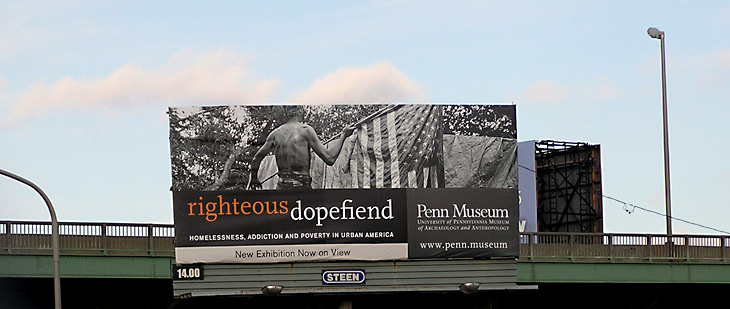
The billboards pushed a ‘15-second’ critique (that could extend to 15 minutes at rush hour) of urban dualism and invisibilized inner-city poverty into an artery of suburban public space in a way we had not thought possible. The Museum ran advertisements in local weeklies including one during the Christmas holidays with Jeff’s photo of Hank hailing passersby with a misspelled panhandling sandwich sign: “Marry Christmas, need work, God Bless.”
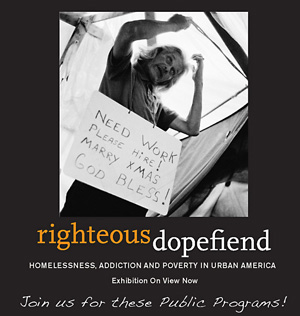 The museum extended the exhibit for an extra year and a half (running from December 2009 to March 2012), and most interesting to us was the way community groups, homeless and addiction services organizations and educators used the space, bringing their clients/patients/inmates/students for visits and reflection sessions. A blackboard and a comment and donation box allowed visitors to leave their input. Perhaps the most moving comments we have received have been from the family members of deceased heroin injectors and crack smokers. There are few public, safe, respectful, serious and forgiving spaces that acknowledge the unresolved anger, quiet confusion and frustrated longing left among close kin by addicted loved ones who have died (Garcia 2011). Most family members are forced to mourn their lost siblings, children or parents in silence—if not shame—and they remain an invisible community. The exhibit seems to allow them to come forward and situate in history and in public policy their family’s solitary painful experience in a larger shared community.
The museum extended the exhibit for an extra year and a half (running from December 2009 to March 2012), and most interesting to us was the way community groups, homeless and addiction services organizations and educators used the space, bringing their clients/patients/inmates/students for visits and reflection sessions. A blackboard and a comment and donation box allowed visitors to leave their input. Perhaps the most moving comments we have received have been from the family members of deceased heroin injectors and crack smokers. There are few public, safe, respectful, serious and forgiving spaces that acknowledge the unresolved anger, quiet confusion and frustrated longing left among close kin by addicted loved ones who have died (Garcia 2011). Most family members are forced to mourn their lost siblings, children or parents in silence—if not shame—and they remain an invisible community. The exhibit seems to allow them to come forward and situate in history and in public policy their family’s solitary painful experience in a larger shared community.
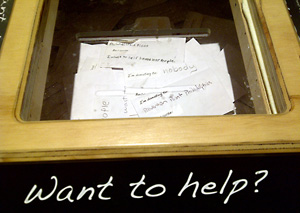 The more avant-garde exhibition space at the Slought Foundation of our initially simultaneous multimedia installation, “Righteous Dopefiend: Voices of the Homeless” ran for less than a month and it reached fewer viewers, primarily the web-based hipster public. More importantly, however, it introduced us to the value and untapped potential of multi-media—especially audio—installations of ethnographic material. For the exhibit, we prepared audio loops of excerpts from our hundreds of hours of recordings and combined them with photos of the daily activities of the characters speaking on the recording. This foray into audio-editing paired with photographs made us realize how much more the sound of voices communicates about racialized ethnicity, class, sex-and-gender, ethnographic rapport, suffering and human emotion than do transcriptions of these same voices frozen into print. Furthermore, the pain, anger, affectation, frustration, hopelessness or thoughtfulness of a tone of voice and turn of phrase are rendered more memorable or poignant by the photos-in-action displayed simultaneously with the audio loop. The limits of agency become evident to audiences listening to conversations-in-actions among the homeless. Stutters, pauses, self-corrections, hyperbole and emotional tones reveal personal ambivalences and bring alive the intimate structural and interpersonal quandaries and inconsistencies that condemn dreams and good intentions to failure—including, in the case of street addicts: safe injection practices, sobriety and consistent relations of social solidarity.
The more avant-garde exhibition space at the Slought Foundation of our initially simultaneous multimedia installation, “Righteous Dopefiend: Voices of the Homeless” ran for less than a month and it reached fewer viewers, primarily the web-based hipster public. More importantly, however, it introduced us to the value and untapped potential of multi-media—especially audio—installations of ethnographic material. For the exhibit, we prepared audio loops of excerpts from our hundreds of hours of recordings and combined them with photos of the daily activities of the characters speaking on the recording. This foray into audio-editing paired with photographs made us realize how much more the sound of voices communicates about racialized ethnicity, class, sex-and-gender, ethnographic rapport, suffering and human emotion than do transcriptions of these same voices frozen into print. Furthermore, the pain, anger, affectation, frustration, hopelessness or thoughtfulness of a tone of voice and turn of phrase are rendered more memorable or poignant by the photos-in-action displayed simultaneously with the audio loop. The limits of agency become evident to audiences listening to conversations-in-actions among the homeless. Stutters, pauses, self-corrections, hyperbole and emotional tones reveal personal ambivalences and bring alive the intimate structural and interpersonal quandaries and inconsistencies that condemn dreams and good intentions to failure—including, in the case of street addicts: safe injection practices, sobriety and consistent relations of social solidarity.
The Critical Potential of Anthropological Methods
The Critical Potential of Anthropological Methods
Anthropology straddles the boundaries of the humanities and the social sciences, generating a scholarly space for critical epistemologies. Over the past century, anthropology differentiated itself from other social science and humanities approaches through its dedication to participant-observation ethnographic fieldwork methods that valorize participatory and subjective engagement with data collection. Fieldwork requires long-term interpersonal contact with the people and processes being researched. Ethnographers are forced to go out into the messy, scary real world and to straddle social power divides. Ethnographers often purposefully violate de facto apartheid divisions of social class, ethnicity and normativity that structure many—if not all—social formations.
Anthropologists cannot escape seeing, feeling and empathizing with the people they study. Our methods impel us to raise problematic questions and confront us ethically and practically with the public stakes of our writing. When our fieldwork methodology is combined with our basic good-enough heuristic principle of cultural relativism, the result can be inherently destabilizing to power, privilege and fossilized common sense. Cultural relativism has been anthropology’s foundation for combating ethnocentrism and valorizing diversity. Furthermore, it introduces an analytical space for a humble (also good-enough), critical self-reflection that is absent from public health. The hermeneutics of generosity that cultural relativism implies is an antidote to righteousness, even though it often prompts some ethnographers to sanitize their data and to bear only good news about the always-worthy people they study. Nevertheless, as anthropologists we benefit from distrusting our capacity to see, feel and report authoritatively.
Acknowledgments
Acknowledgments
Research support was provided by National Institutes of Health (NIH) grants: DA 010164. Comparative and background data was supported by NIH grants DA027204, DA027689, DA27599, AA020331 and the California HIV/AIDS Research Program ID08-SF-049. George Karandinos edited the multiple drafts and the photographs are Jeff Schonberg’s copyright. A preliminary shorter “anthropological version” of this article appeared originally in 2011 in City and Society 23:1:2-12.
Over the years, additional formal and informal collaborators on the ethnographic team included (in alphabetical order): Maxwell Burton, Dan Ciccarone, Laurie Kain Hart, Mark Lettiere, Ann Magruder, Fernando Montero, Joelle Morrow, Charles Pearson, and Jim Quesada.
Philippe Bourgois is the Richard Perry University Professor of Anthropology and Family & Community Medicine at the University of Pennsylvania. He is the author of three books and several edited volumes, including award winning In Search of Respect: Selling Crack in El Barrio (Cambridge, 1995), Righteous Dopefiend (co-authored with Jeff Schonberg, University of California, 2009), Ethnicity at Work: Divided Labor on a Central American Banana Plantation (Johns Hopkins, 1989) and Violence in War and Peace (Co-edited with Nancy Scheper-Hughes, Blackwell 2004). He has published over 150 articles on social inequality, concentrated urban poverty, violence, labor migration, ethnic conflict, homelessness, substance abuse and HIV. Since 1996 he has been the Principle Investigator on a continuously funded National Institutes of Health R01 grant examining the HIV risk environment of indigent drug users. For more information, please visit http://www.philippebourgois.net.
References
References
Behforouz, H., P. Farmer and J. Mukherjee. (2004). From Directly Observed Therapy to Accompagnateurs: Enhancing Aids Treatment Outcomes in Haiti and in Boston. Clinical Infectious Diseases. 38(Supplement 5):S429-S436.
Bourgois, P. (1989). Ethnicity at Work: Divided Labor on a Central American Banana Plantation. Baltimore: Johns Hopkins University Press.
Bourgois, P. (2003). In Search of Respect: Selling Crack in El Barrio. New York: Cambridge University Press.
Bourgois, P. and J. Schonberg. (2009). Righteous Dopefiend. Berkeley: University of California Press.
Conover, T. (2000). Newjack: Guarding Sing Sing. New York: Random House.
Garcia, A. (2011). Reading Righteous Dopefiend with My Mother. Anthropology Now. 2:3:31-36.
Harvey, D. (2005). A Brief History of Neoliberalism. Oxford: Oxford University Press.
McCall, L., and C. Percheski. (2010). Income Inequality: New Trends and Research Directions. Annual Review of Sociology. 36:329-347.
Scheper-Hughes, N. (2009). Making Anthropology Public. Anthropology Today. 25(4):1-3.
Taussig, M. (1986). Shamanism, Colonialism, and the Wild Man: A Study in Terror and Healing. Chicago: University of Chicago Press.
Wacquant, L. ( 2009). Prisons of Poverty. Minneapolis: University of Minnesota Press.


